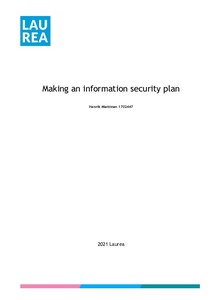Comparing the Finnish, EU and NATO security strategies
Fouché, Eduard (2025)
Fouché, Eduard
2025
All rights reserved. This publication is copyrighted. You may download, display and print it for Your own personal use. Commercial use is prohibited.
Julkaisun pysyvä osoite on
https://urn.fi/URN:NBN:fi:amk-2025052917927
https://urn.fi/URN:NBN:fi:amk-2025052917927
Tiivistelmä
As a result of the Russian invasion of Ukraine in 2022 the European Union (EU) and the North Atlantic Treaty Organization (NATO) implemented new security strategies. This was to address the now returned threat of conventional military conflict while also having to address the other threats which had shaped security strategy since the end of the cold war such as terrorism and hybrid actions. Finland however had maintained the same security strategy since the early 2000s being the first nation to implement a comprehensive model and as such provided a possible solution to the new challenge faced by the EU and NATO.
The following body of work was commissioned by Laurea res/lab as part of a larger project to develop comprehensive security within the EU and NATO. The purpose of this thesis was to identify differences in the respective strategies in order to provide a list of possible focal points upon which the comprehensive model can be improved in the EU and NATO. This was done utilizing a qualitative analysis method. The thesis identified main themes from the Finnish security strategy for society, the EU (a) strategic compass for security and defense, and the NATO Strategic concept 2022. Having identified main themes the thesis compared and contrasted them to each other while also accounting for possible contextual factors, to identify key differences upon which final insights were made.
As the results suggest, the strategies displayed similarities in goals and focus due to contextual reasons such as the overlap of membership between the EU and NATO. Differences identified were largely attributed to experience with a comprehensive approach or the size and nature of the organizations themselves. The key differences were identified as the emphasis of the role of the individual and a focus on an international rules-based order. Utilizing these the thesis made insights into ways the EU and NATO could develop their own security strategies.
The following body of work was commissioned by Laurea res/lab as part of a larger project to develop comprehensive security within the EU and NATO. The purpose of this thesis was to identify differences in the respective strategies in order to provide a list of possible focal points upon which the comprehensive model can be improved in the EU and NATO. This was done utilizing a qualitative analysis method. The thesis identified main themes from the Finnish security strategy for society, the EU (a) strategic compass for security and defense, and the NATO Strategic concept 2022. Having identified main themes the thesis compared and contrasted them to each other while also accounting for possible contextual factors, to identify key differences upon which final insights were made.
As the results suggest, the strategies displayed similarities in goals and focus due to contextual reasons such as the overlap of membership between the EU and NATO. Differences identified were largely attributed to experience with a comprehensive approach or the size and nature of the organizations themselves. The key differences were identified as the emphasis of the role of the individual and a focus on an international rules-based order. Utilizing these the thesis made insights into ways the EU and NATO could develop their own security strategies.
Kokoelmat
Samankaltainen aineisto
Näytetään aineisto, joilla on samankaltaisia nimekkeitä, tekijöitä tai asiasanoja.
-
Research on Optimization of Security Screening Process in AB Airport
Hu, Jianfeng (2025)With the rapid development of the air transportation industry, the efficiency and safety of the airport security check process has become a core issue of concern for the industry. This paper takes AB airport as the research ... -
Making an information security plan
Miettinen, Henrik (2021)The development objective of this thesis was to create a working, efficient and solid information security plan for a small-sized company. This thesis used qualitative and development methods, such as qualitative interview, ... -
Cybersecurity development and business continuity plan for car dealership
Valasvuo, Santeri (2022)The purpose of this thesis was to investigate the capability of the case company to meet the challenges of current and growing security threats and to come up with a development plan to increase the level of cyber security ...



